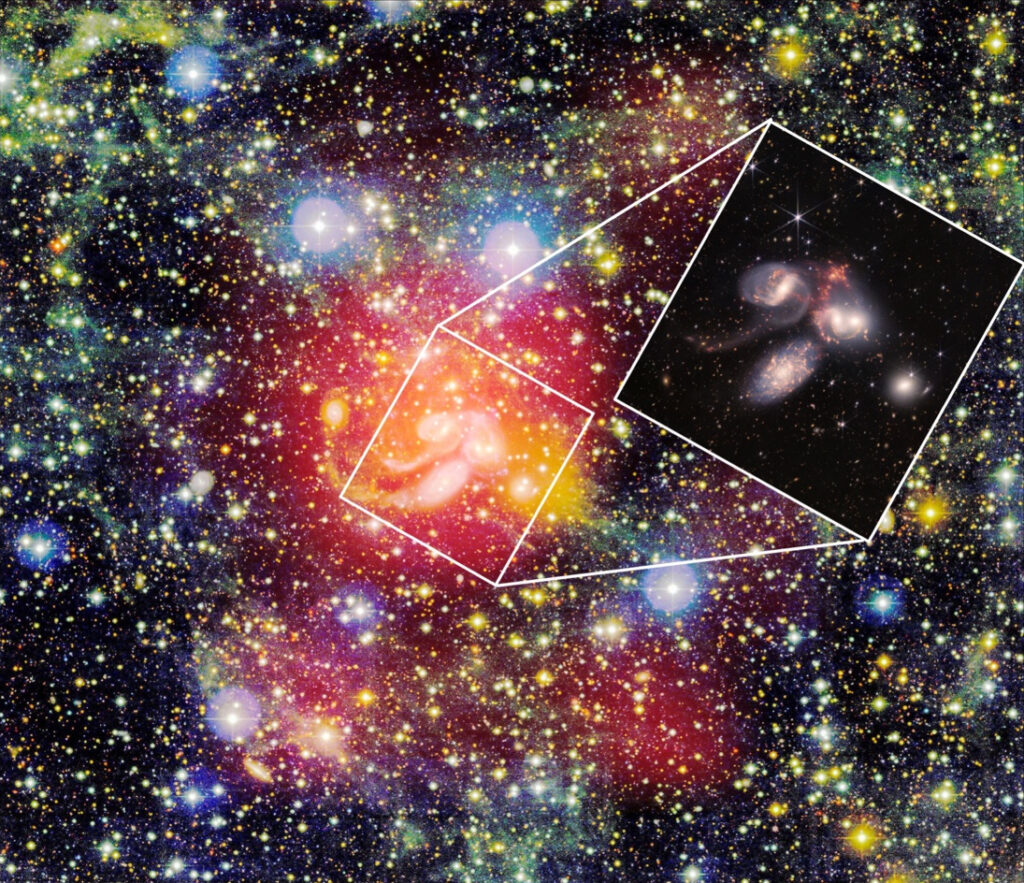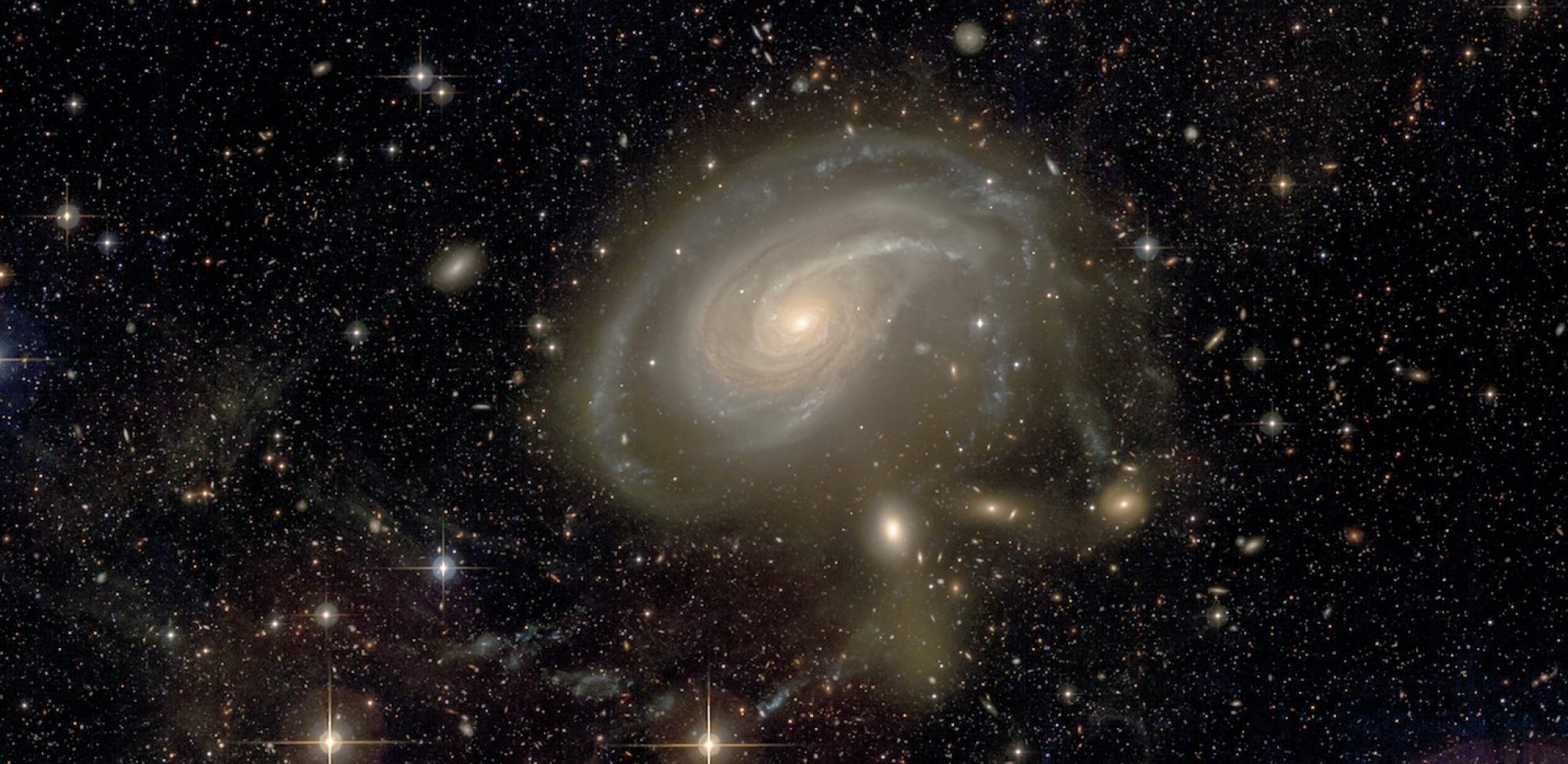Découverte de la plus grande structure de gaz atomique autour d’un groupe de galaxies

L’évolution des galaxies est principalement gouvernée par l’accrétion d’hydrogène neutre atomique du milieu intergalactique, et par la conversion de ce gaz en étoiles. Les observations permettant de détecter du gaz atomique dans et autour des galaxies sont donc cruciales pour les modèles de formation et d’évolution des galaxies.
Observer dans le domaine radio l’émission de la raie à 21 cm de l’hydrogène atomique est la méthode la plus directe pour explorer le gaz atomique. Le radiotélescope sphérique de 500 mètres d’ouverture (FAST), construit dans le Guizhou en Chine, a ouvert une nouvelle fenêtre sur le gaz atomique dans l’Univers, en particulier pour le gaz diffus à faible densité loin des galaxies.
Une équipe internationale dirigée par Cong Xu (NAOC), et impliquant Pierre-Alain Duc (CNRS, Observatoire astronomique de Strasbourg), a utilisé le radiotélescope FAST pour effectuer une cartographie profonde de la région entourant le “quintette de Stephan”, un groupe compact de galaxies. Grâce à l’émission à 21 cm, ils ont découvert que le gaz atomique s’étendait sur 2 millions d’années-lumière (20 fois la taille de la Voie lactée). C’est la plus grande structure de gaz atomique jamais découverte autour de galaxies.
Continue reading “Découverte de la plus grande structure de gaz atomique autour d’un groupe de galaxies”A 0.6 Mpc HI Structure Associated with Stephan’s Quintet (associated paper)

Stephan’s Quintet (SQ, distance=85 Mpc) is unique among compact groups of galaxies. Observations have previously shown that interactions between multiple members, including a high-speed intruder galaxy currently colliding into the intragroup medium, have likely generated tidal debris in the form of multiple gaseous and stellar filaments, the formation of tidal dwarfs and intragroup-medium starbursts, as well as widespread intergalactic shocked gas. The details and timing of the interactions/collisions remain poorly understood because of the multiple nature. Here we report atomic hydrogen (HI) observations in the vicinity of SQ with a smoothed sensitivity of 1σσ=4.2 ×1016cm−2×1016cm−2 per channel (ΔΔv=20 km s−1−1; angular-resolution=4′), which are about two orders of magnitude deeper than previous observations. The data reveal a large HI structure (linear scale ~0.6 Mpc) encompassing an extended source of size ~0.4 Mpc associated with the debris field and a curved diffuse feature of length ~0.5 Mpc attached to the south edge of the extended source. The diffuse feature was likely produced by tidal interactions in early stages of SQ (>1 Gyr ago), though it is not clear how the low density HI gas (NHI≤1018cm−2HI≤1018cm−2) can survive the ionization by the inter-galactic UV background on such a long time scale. Our observations require a rethinking of gas in outer parts of galaxy groups and demand complex modeling of different phases of the intragroup medium in simulations of group formation.
Xu et al., 2022, Nature 610, 461
Images de science : Voir le ciel moins noir, ou la renaissance de l’astronomie profonde

Article the Conversation, par Pierre-Alain Duc, sur le renouveau de l’imagerie profonde

Multi-scale gridded Gabor attention for cirrus segmentation

In this paper, we address the challenge of segmenting global contaminants in large images. The precise delineation of such structures requires ample global context alongside un- derstanding of textural patterns. CNNs specialise in the latter, though their ability to generate global features is limited. At- tention has been used to measure long range dependencies in images, capturing global context, however this incurs a large computational cost.
Continue reading “Multi-scale gridded Gabor attention for cirrus segmentation”Origin of the differences in rotational support among early-type galaxies: The case of galaxies outside clusters

Context: Early-type galaxies (ETGs) are divided into slow and fast rotators (FRs and SRs) according to the degree of ordered rotation of their stellar populations. Cosmological hydrodynamical simulations indicate that galaxies form as FRs before their rotational support decreases, usually because of mergers.
Aims: We aimed to investigate this process observationally for galaxies outside of clusters..
Methods: We made use of the fact that different merger types leave different traces that have different lifetimes. We statistically analyzed multiple characteristics of galaxies that are expected to be influenced by mergers, such as tidal features, kinematically distinct cores, and stellar ages. They were taken from the MATLAS and ATLAS3D databases. Through multilinear regression we identified the quantities that, at a fixed mass and environmental density of the galaxy, significantly correlate with a measure of the ordered rotation of the galaxy, λReN.
Characterization of Low Surface Brightness structures in annotated deep images

The characterization of Low Surface Brightness (LSB) stellar structures around galaxies such as tidal debris of on-going or past collisions is essential to constrain models of galactic evolution. Our goal is to obtain quantitative measurements of LSB structures identified in deep images of samples consisting of hundreds of galaxies. We developed an online annotation tool that enables contributors to delineate the shapes of diffuse extended stellar structures, as well as artefacts or foreground structures. All parameters are automatically stored in a database which may be queried to retrieve quantitative measurements. We annotated LSB structures around 352 nearby massive galaxies with deep images obtained with the CFHT as part of two large programs: MATLAS and UNIONS/CFIS.
Continue reading “Characterization of Low Surface Brightness structures in annotated deep images”Origin of the spectacular tidal shells of the galaxy NGC 474

Context. The lenticular galaxy NGC 474 hosts a rich system of tidal shells and streams, some of which are exceptionally bright. Two teams recently presented spectroscopic observations of the brightest shells. These were the first shell spectra ever published. They studied the stellar populations of the shell, of the center of the galaxy and of its globular clusters.
Aims. The precise formation scenario for the tidal features of this prominent galaxy however still remained unclear. Here, we add further clues on their formation from the radii of the shells, and we present a scenario for the formation of the tidal features that seems to be unique and explaining all available data.
Methods. Shell radii are analyzed with the shell identification method, and we run self-consistent simulations of the formation of the tidal features.
HI observations of the MATLAS dwarf and ultra-diffuse galaxies

Context. The HI content of dwarf galaxies provides valuable insights into the effects of the internal processes and the environment on galaxy morphology and evolution.
Aims. We investigate the HI properties of the 2210 dwarf and ultra-diffuse galaxies (UDGs) in the low to moderate density environ- ments of the Mass Assembly of early-Type GaLAxies with their fine Structures (MATLAS) survey. We examine how these properties correlate with the optical properties, morphology and local environment of the dwarfs.
Methods. We make use of the HI data obtained with the Westerbork Synthesis Radio Telescope in the context of the ATLAS3D HI survey. These HI observations are combined with the extragalactic HI sources from the ALFALFA survey study the HI content in the MATLAS dwarfs located in the targeted regions of the sky.

